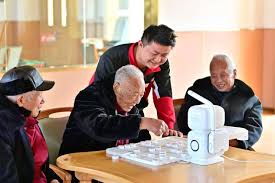By Li Haoran, People’s Daily
In the rapidly evolving landscape of health consumption, China is embracing the transformative power of “embodied intelligence.”FromAI-driven glucose monitorspredicting blood sugar trends and generating personalized dietary plans, tosmart mattressesdetecting apnea risks, adjusting sleep posture, and activating air purification systems before snoring begins, the integration of AI into daily health routines is set to revolutionize the way people care for themselves.
Recently, China released a plan on special initiatives to boost consumption, with a special focus on launching health consumption initiatives. With strong policy support, health consumption has gained significant momentum. Local governments in the country are rapidly driving the development of new quality productive forces, particularly embodied intelligence, creating a fertile ground for the growth of the healthcare industry.
Beijing has made bold moves,unveiling a three-year action plan for embodied intelligence innovation and industrial growth, backed by a 100-billion-yuan fund. The city also launched “Huisi Kaiwu,”the world’s first universal embodied artificial intelligence (AI) platform that supports multiple body types and scenarios, and hosted the China Embodied AI Conference.
In tandem with these governmental efforts, Chinese consumers are increasingly focused on their health, reflecting a profound societal shift toward proactive wellness management. A McKinsey survey revealed that 62 percent of Chinese consumers prioritize health in their daily lives – surpassing the United States (41 percent) and the United Kingdom (29 percent).
Meanwhile, consumer demand in China is shifting from simply acquiring products to seeking an enhanced quality of life, with individuals increasingly looking for personalized, tailored health solutions. A notable example is the rising demand for assistive technology. People with mobility challenges eagerly await the mass production of hip-assist exoskeletons, highlighting a market gap and the pressing need for innovative solutions.
This shift is not limited to younger consumers – businesses once assumed that tech-savvy millennials were the primary adopters of new health technologies. However, surveys reveal that elderly consumers are also highly engaged in health management, with many scrutinizing nutrition labels and tracking their calories.
Statistics from the Beijing Municipal Bureau of Statistics show that over 80 percent of seniors in Beijing are willing to use smart devices, particularly for health purposes. This presents a significant opportunity for companies to refine theirofferings, catering to this growing demographic by creating enhanced scenarios and experiences.
Success in this evolving market often requires rethinking traditional business models. Consider the case of Linjia village in east China’s Shandong province, where the local “Zhushan Ecological Valley”has tapped into the burgeoning wellness tourism trend. The village’s hotel wellness cabins – priced at over 1,000 yuan ($136.2) per night – are in high demand, and forest yoga classes attract urbanites willing to pay a premiumfor a rejuvenating experience. Even the village’s strontium-rich mineral water, sourced from deep underground, is selling effortlessly.
This success goes beyond selling picturesque landscapes – it’s about selling health. By aligning itself with the wellness agriculture movement, the village has tapped into the thriving health consumption trend, positioning itself at the forefront of this growing market.
As Antoine de Saint-Affrique, CEO of French food group Danone, remarked at the China Development Forum 2025, China’s transition from “eating enough” to “eating well and healthily” reflects the country’s broader economic aspirations and its pursuit of a better life. This just echoes the global confidence in China’s burgeoninghealth consumption market.
By integrating digital intelligence, accelerating industrial growth, and enhancingconsumer experiences, China’s health consumption sector is set for expansive growth and a dynamic future.
